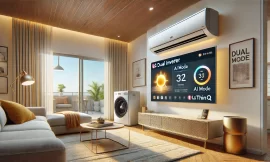Get to know the Evolution of Smart ACs and the tech innovations behind enhanced efficiency, remote control, and tailored climate experiences.

Embark on a transformative journey through the evolution of smart AC technology. From humble beginnings to AI-powered innovation, discover how these systems have reshaped home cooling for the modern era.
Evolution of Smart AC: In the bustling city of Mumbai, where temperatures can soar to uncomfortable heights, air conditioning plays a crucial role in keeping homes and businesses cool and comfortable. Over the years, the technology behind air conditioning has evolved significantly, from simple manual systems to sophisticated AI-driven solutions. Let’s take a closer look at this evolution and how it has transformed the way we cool our indoor spaces.
The Age of Manual AC Systems
In the past, air conditioning systems relied on manual controls to regulate temperature settings and airflow. Users had to adjust dials or switches on the unit itself to achieve the desired level of cooling. While these systems were effective to some extent, they lacked precision and often led to energy wastage.
Challenges of Manual Systems:
- Limited control over temperature
- Inefficient energy consumption
- Prone to human error
Introduction of Programmable Thermostats
As technology advanced, programmable thermostats emerged as a game-changer in the world of air conditioning. These devices allowed users to set specific temperature schedules, enabling them to optimize energy usage and maintain consistent comfort levels throughout the day.
Benefits of Programmable Thermostats:
- Energy efficiency
- Customizable temperature settings
- Remote access and control
Smart AC Systems: The Era of Connectivity
With the rise of the Internet of Things (IoT), smart AC systems have taken center stage, offering a new level of convenience and efficiency. These systems can be controlled remotely via smartphones or smart home devices, allowing users to adjust settings and monitor energy consumption from anywhere.
Features of Smart AC Systems:
- Wi-Fi connectivity
- Energy usage tracking
- Adaptive cooling based on occupancy
The Emergence of AI-Driven Cooling Systems
As artificial intelligence continues to revolutionize various industries, the HVAC sector is no exception. AI-driven cooling systems leverage machine learning algorithms to analyze data, predict user preferences, and optimize performance automatically. These systems can learn user habits and adjust settings accordingly, ensuring maximum comfort with minimal energy waste.
Advantages of AI-Driven Systems:
- Energy savings
- Enhanced comfort
- Predictive maintenance
Conclusion: Evolution of Smart AC’s
The evolution of air conditioning from manual systems to AI-driven solutions has brought about significant improvements in energy efficiency, comfort, and convenience. In Mumbai, where the need for effective cooling is paramount, these advancements are transforming the way we stay cool indoors. As technology continues to advance, we can expect even more innovative solutions to enhance our AC experience and reduce our environmental impact. Embracing smart and AI-driven cooling systems is not just a trend but a step towards a more sustainable and comfortable future.


